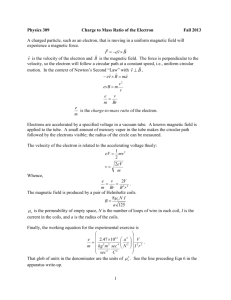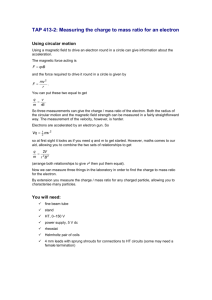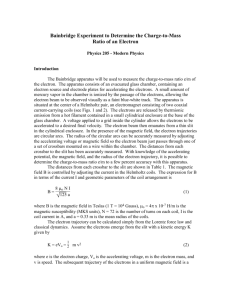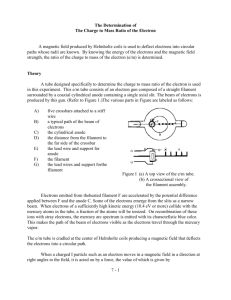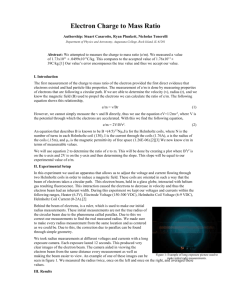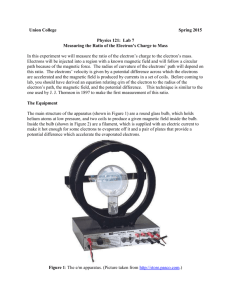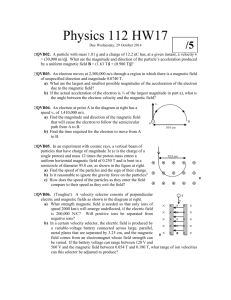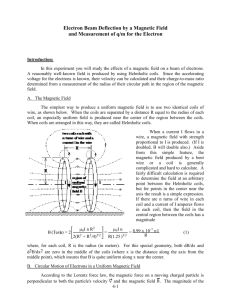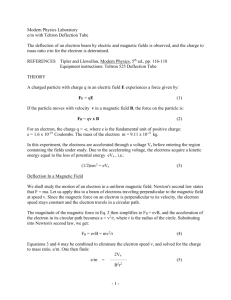Determining Charge to Mass Ratio of the Electron
advertisement
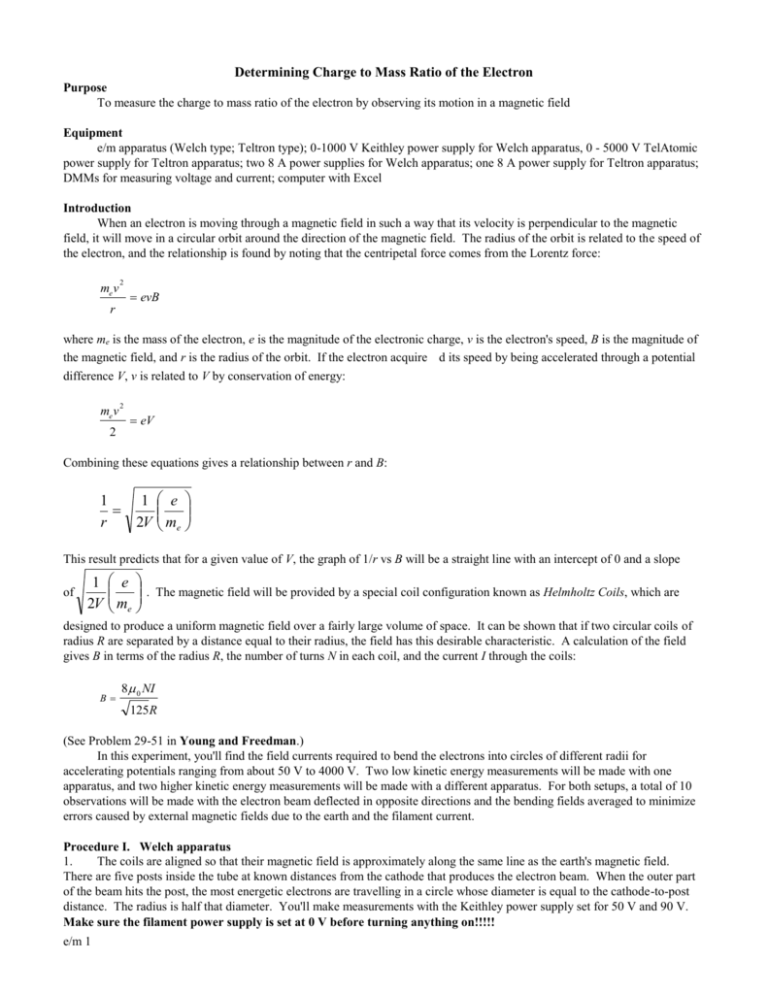
Determining Charge to Mass Ratio of the Electron Purpose To measure the charge to mass ratio of the electron by observing its motion in a magnetic field Equipment e/m apparatus (Welch type; Teltron type); 0-1000 V Keithley power supply for Welch apparatus, 0 - 5000 V TelAtomic power supply for Teltron apparatus; two 8 A power supplies for Welch apparatus; one 8 A power supply for Teltron apparatus; DMMs for measuring voltage and current; computer with Excel Introduction When an electron is moving through a magnetic field in such a way that its velocity is perpendicular to the magnetic field, it will move in a circular orbit around the direction of the magnetic field. The radius of the orbit is related to the speed of the electron, and the relationship is found by noting that the centripetal force comes from the Lorentz force: me v 2 evB r where me is the mass of the electron, e is the magnitude of the electronic charge, v is the electron's speed, B is the magnitude of the magnetic field, and r is the radius of the orbit. If the electron acquire d its speed by being accelerated through a potential difference V, v is related to V by conservation of energy: me v 2 eV 2 Combining these equations gives a relationship between r and B: 1 r 1 2V e me This result predicts that for a given value of V, the graph of 1/r vs B will be a straight line with an intercept of 0 and a slope of 1 2V e me . The magnetic field will be provided by a special coil configuration known as Helmholtz Coils, which are designed to produce a uniform magnetic field over a fairly large volume of space. It can be shown that if two circular coils of radius R are separated by a distance equal to their radius, the field has this desirable characteristic. A calculation of the field gives B in terms of the radius R, the number of turns N in each coil, and the current I through the coils: B 8 0 NI 125R (See Problem 29-51 in Young and Freedman.) In this experiment, you'll find the field currents required to bend the electrons into circles of different radii for accelerating potentials ranging from about 50 V to 4000 V. Two low kinetic energy measurements will be made with one apparatus, and two higher kinetic energy measurements will be made with a different apparatus. For both setups, a total of 10 observations will be made with the electron beam deflected in opposite directions and the bending fields averaged to minimize errors caused by external magnetic fields due to the earth and the filament current. Procedure I. Welch apparatus 1. The coils are aligned so that their magnetic field is approximately along the same line as the earth's magnetic field. There are five posts inside the tube at known distances from the cathode that produces the electron beam. When the outer part of the beam hits the post, the most energetic electrons are travelling in a circle whose diameter is equal to the cathode-to-post distance. The radius is half that diameter. You'll make measurements with the Keithley power supply set for 50 V and 90 V. Make sure the filament power supply is set at 0 V before turning anything on!!!!! e/m 1 2. The accelerating potential is provided by a 0 - 1000 V Keithely power supply. Turn the the Keithley unit on and set it for 50 V. Turn on all the multimeters sitting around. Make sure the filament power supply is set a 0 V and turn it on. SLOWLY raise the voltage until the filament current is around 4 A and you're reading a beam current of 2 - 3 mA. You should be able to see the beam in a darkened room. If you can't, call the instructor. If everything is working properly, record the filament current and beam current in your notebook for future reference. 3. Record the accelerating potential in your notebook. (Use the reading from the voltmeter connected from the anode to the cathode, not the control setting on the power supply. The accelerating voltage will be less than the power supply setting because of a voltage drop across the meter being used to monitor the beam current.) Turn the field supply on and make sure the beam deflects toward the front of the tube as the current is increased. One person should view the tube from above by standing on a firm support. Record the field currents required to make the outer edge of the electron beam just intersect the outer edges of the five posts in the tube. Turn the field current to zero and carefully rotate the tube in its clamps until it's upside down. Reverse the power supply connections to the Helmholtz coils and repeat the five current measurements. In the analysis, you'll use the average of these currents to find the magnetic field. This technique effectively cancels the effects of constant external magnetic fields from the earth and from the filament current. 4. Increase the accelerating voltage setting to 90 V. Record the voltmeter reading and repeat Step 3. e/m 2
